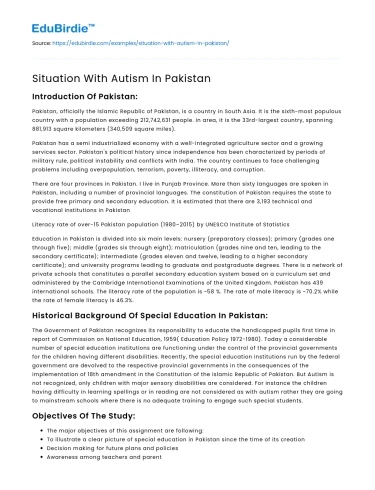Introduction Of Pakistan:
Pakistan, officially the Islamic Republic of Pakistan, is a country in South Asia. It is the sixth-most populous country with a population exceeding 212,742,631 people. In area, it is the 33rd-largest country, spanning 881,913 square kilometers (340,509 square miles).
Pakistan has a semi industrialized economy with a well-integrated agriculture sector and a growing services sector. Pakistan's political history since independence has been characterized by periods of military rule, political instability and conflicts with India. The country continues to face challenging problems including overpopulation, terrorism, poverty, illiteracy, and corruption.
Save your time!
We can take care of your essay
- Proper editing and formatting
- Free revision, title page, and bibliography
- Flexible prices and money-back guarantee
There are four provinces in Pakistan. I live in Punjab Province. More than sixty languages are spoken in Pakistan, including a number of provincial languages. The constitution of Pakistan requires the state to provide free primary and secondary education. It is estimated that there are 3,193 technical and vocational institutions in Pakistan
Literacy rate of over-15 Pakistan population (1980–2015) by UNESCO Institute of Statistics
Education in Pakistan is divided into six main levels: nursery (preparatory classes); primary (grades one through five); middle (grades six through eight); matriculation (grades nine and ten, leading to the secondary certificate); intermediate (grades eleven and twelve, leading to a higher secondary certificate); and university programs leading to graduate and postgraduate degrees. There is a network of private schools that constitutes a parallel secondary education system based on a curriculum set and administered by the Cambridge International Examinations of the United Kingdom. Pakistan has 439 international schools. The literacy rate of the population is ~58 %. The rate of male literacy is ~70.2% while the rate of female literacy is 46.3%.
Historical Background Of Special Education In Pakistan:
The Government of Pakistan recognizes its responsibility to educate the handicapped pupils first time in report of Commission on National Education, 1959( Education Policy 1972-1980). Today a considerable number of special education institutions are functioning under the control of the provincial governments for the children having different disabilities. Recently, the special education institutions run by the federal government are devolved to the respective provincial governments in the consequences of the implementation of 18th amendment in the Constitution of the Islamic Republic of Pakistan. But Autism is not recognized, only children with major sensory disabilities are considered. For instance the children having difficulty in learning spellings or in reading are not considered as with autism rather they are going to mainstream schools where there is no adequate training to engage such special students.
Objectives Of The Study:
- The major objectives of this assignment are following:
- To illustrate a clear picture of special education in Pakistan since the time of its creation
- Decision making for future plans and policies
- Awareness among teachers and parents as well
- To highlight the shortage of facilities in field of special education
- Exploring autism and its implications in primary setting
Inclusion And Autism:
Inclusion is derived from the word include which means to add up something to make part of a particular thing. For example to enroll a student in Northampton University to make him part of that particular University. Inclusive education is education that includes everyone either they are disabled or non-disabled in mainstream schools. The children with learning disabilities get the opportunity to learn with normal children, to play with them or work with them. On the other hand special schools are only for children with special needs. This is called exclusion or segregation as these schools are only for children with learning disabilities.
“Autism is a lifelong, developmental disability that affects how a person communicates with and relates to other people, and how they experience the world around them.”[1]
Autism is also called Autism Spectrum Disorder (ASD), distortion in verbal communication, social interaction and repetitive behaviors.
There are 3 common types of Autism:
- Autistic Disorder
- Asperger Syndrome
- Pervasive Developmental Disorder
As I am working on special education in Pakistan, autism is not recognized in my country. There are only 4 common types of special children:
- Deaf
- Blind
- Mental distortion
- Physical handicapped
Beside these there is no other type related to autism. I worked in a primary school in my country I had a child with learning disabilities who was in same grade for last 4 years. We were not permitted to upgrade him and also do not have enough material or adequate training to teach that child as that was a mainstream school. So there was Inclusion but no desired results.
https://www.autism.org.uk/about/what-is.aspx?gclid=EAIaIQobChMItdve4Mq93wIVRrDtCh3Djw1iEAAYAiAAEgKrhvD_BwE






 Stuck on your essay?
Stuck on your essay?

